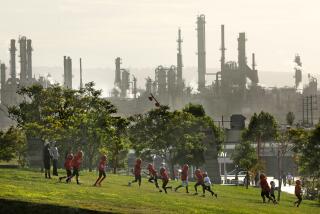Explosion in Torrance Injures 20
A gas explosion ripped through a Torrance oil refinery Wednesday afternoon, sending flames 40 feet into the air and injuring at least 20 people, at least half a dozen of them seriously.
Officials at the Mobil Oil refinery said the blast occurred at 3:15 p.m. when an elevated pipe carrying liquid petroleum gas apparently sprang a leak, releasing flammable vapor into the air.
William Buckalew, Mobil environmental health and safety manager, said the hydrocarbons exploded within moments, creating a fire that burned for about half an hour before it was extinguished by Torrance firefighters and Mobil’s own crews.
Portions of the refinery were shut down after the blast, but most of the plant was operating normally by 6 p.m. Buckalew said it was unclear what had ignited the hydrocarbon vapors, adding that the explosion is under investigation. Hydrocarbons themselves will not explode upon contact with the air, he said.
Witnesses said the only sign that something was amiss was a drift of white smoke that snaked from an overhead pipe and set off a stampede of alarmed, orange-suited crews below.
“I believe God gave us a warning,” said Roy Hicks, a 36-year-old Lawndale carpenter who was working at the plant for a Mobil subcontractor when the 10-foot cloud of what smelled like car exhaust floated down around around his head.
Hicks said he was sprinting toward a fence outside the plant when the force of the blast smacked him to the ground. He was not seriously injured, but others were, including a man who was knocked off a 20-foot ladder by the shock waves, two men burned over 7% and 17% of their bodies, a fourth man who suffered third-degree burns on his face and two others who were taken directly to the burn unit at Torrance Memorial Medical Center.
By nightfall, hospitals in the area of the plant, near 190th Street and Crenshaw Boulevard, had reported treating at least 17 people for minor to moderate burns and smoke inhalation.
However, Mobil officials, who were keeping their own tally, said a total of 20 workers were treated at the four hospitals--Little Company of Mary, Torrance Memorial, Harbor-UCLA Medical Center and Memorial Hospital of Gardena. Only one of the injured was identified as a Mobil employee, company officials said; the rest are believed to have been contract workers.
The blast was not severe enough to cause the evacuation of any nearby neighborhoods, officials said. Spokesmen at Mobil reported that there was “no off-site impact” from the blast.
The South Coast Air Quality Management District, however, reported that it is investigating whether any hydrogen sulfide--a noxious gas that can cause nausea and shortness of breath--was released from the refinery as a result of the explosion, spokesman Bill Kelly said.
The district is also studying whether fallout from the explosion might include asbestos from pipe insulation. Kelly advised refinery neighbors not to touch unknown debris that they might find in their yards and to contact the district with questions.
Wednesday’s explosion was not the first refinery accident to rock the South Bay. In October, 1992, an explosion at the Texaco refinery in Wilmington injured 16 workers, and 500 nearby residents were evacuated. That blast--felt throughout the Los Angeles Basin--was blamed on a worn pipe near a hydrogen processing unit.
Earlier that same year, in January, an accidental blast of steam at Chevron’s El Segundo refinery injured 10 contract maintenance workers.
And Mobil itself has had various accidents at the same plant over the years, including two that have long served as grist for a bitter battle between the city of Torrance and the oil company over the safety of the Mobil facility.
In 1979, a woman was incinerated when her car stalled at the Mobil plant on her way to a concert. When she tried to start her car, a spark ignited fumes that had leaked from a tank farm.
And in November, 1987, an overflow of highly toxic hydrofluoric acid precipitated a major explosion and a 15-hour fire that caused $17 million in property damage, but no serious injuries.
The city of Torrance sued Mobil after the accident, but the parties reached a settlement calling for a safety adviser to monitor the facility. Mobil also agreed to phase out the use of hydrofluoric acid by 1997 or come up with a substitute by the end of this year.
Initial accounts of Wednesday’s accident left it unclear whether it was caused by any of the factors that led to earlier accidents.
Hydrofluoric acid was not involved or released during the blast, Buckalew said. Rather, he said, the substance involved was the less dangerous liquid hydrocarbon, which was in a line leading into the refinery’s alkylation unit, where the octane of the gasoline is increased.
Although the alkylation unit itself was not involved in the blast, it was shut down Wednesday in the wake of the accident because of damage to the feed line, officials said.
Buckalew said it was unclear how the hydrocarbon had escaped the suspect pipe, which was one of dozens in a “pipe rack” about 20 feet above the ground in the north-central sector of the refinery.
Times staff writers Gordon Dillow and Ted Johnson and correspondents Mary Guthrie, Jeff Kass and Jon Garcia contributed to this story.
More to Read
Sign up for Essential California
The most important California stories and recommendations in your inbox every morning.
You may occasionally receive promotional content from the Los Angeles Times.










